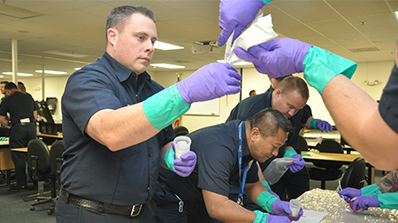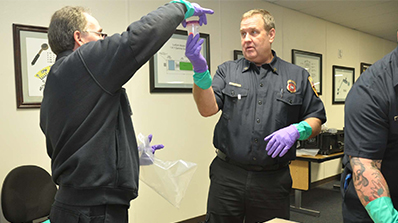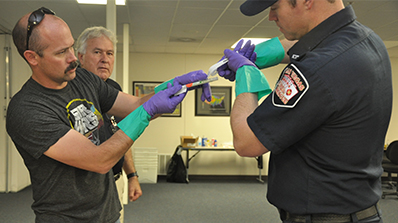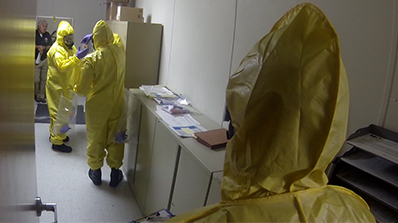
Recently, NNSS’ Fire & Rescue (F&R) hosted a series of training classes for local firefighters in Southern Nevada. Five instructors, subject matter experts from Louisiana State University (LSU)’s National Center for Biomedical Research and Training, traveled to the NNSS to teach advanced hazardous materials sampling. The F&R students, already trained in basic sampling, were from the NNSS as well as Las Vegas, Henderson and Nye County.
“This was a great opportunity for the NNSS to capture all the departments training together,” said NNSS F&R Supervisor Jemmy Castro.
The 39 students practiced how to don latex gloves and properly bag and tag items and substances they may encounter during emergency calls that involve biomedical or hazardous materials. The items they used were from heavy black F&R equipment trunks full of gauze rolls, boxes of gloves, bags, tags and labels, swabs, urine containers, vials, hemostatic clamps, biohazard stickers and other such items. They also learned how to use common household item such as dish detergent, isopropyl alcohol, even Ben-Gay ointment when out in the field.
The LSU instructors included: Jeff Borkowski (senior lead instructor), Chuck Counts, Charles Smith, Joe Wilson and John Larocchia.
This training was made available through the National Domestic Preparedness Consortium (NDPC). LSU’s National Center for Biomedical Research and Training is among seven federal training partners who make up the NDPC that “prepares the nation through training.” The NDPC is a Department of Homeland Security/Federal Emergency Managment Agency training partner providing high-quality training to emergency responders throughout the U.S. and its territories under NDPC’s Homeland Security National Training Cooperative Agreement. The National Nuclear Security Admnistration’sCTOS-Center for Radiological/Nuclear Training at the NNSSis also an NDPC partner.
Preparedness is a shared, national responsibility requiring our active participation to prepare America to address its threats. For more information, visit:www.ndpc.us.



